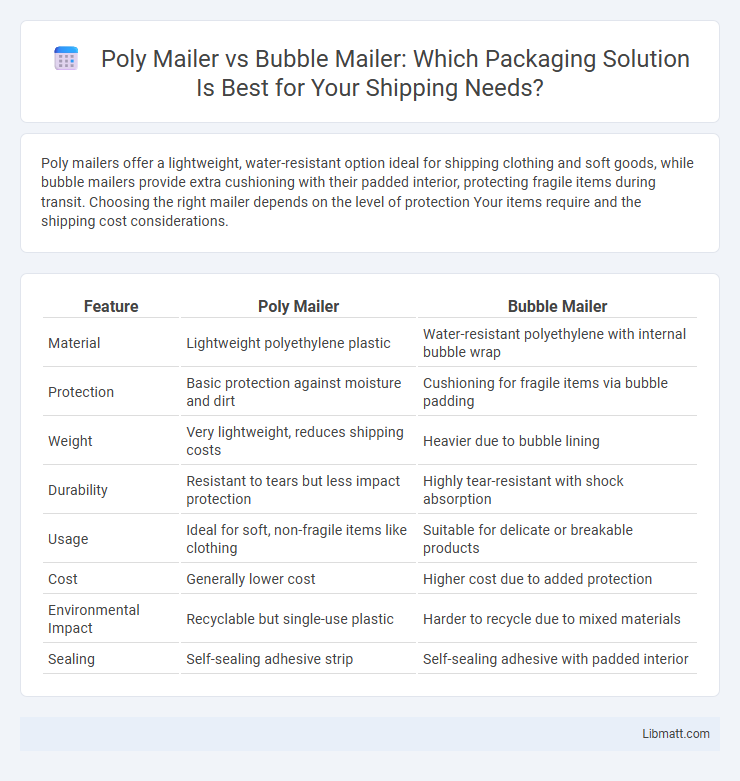Poly mailers offer a lightweight, water-resistant option ideal for shipping clothing and soft goods, while bubble mailers provide extra cushioning with their padded interior, protecting fragile items during transit. Choosing the right mailer depends on the level of protection Your items require and the shipping cost considerations.
Table of Comparison
| Feature | Poly Mailer | Bubble Mailer |
|---|---|---|
| Material | Lightweight polyethylene plastic | Water-resistant polyethylene with internal bubble wrap |
| Protection | Basic protection against moisture and dirt | Cushioning for fragile items via bubble padding |
| Weight | Very lightweight, reduces shipping costs | Heavier due to bubble lining |
| Durability | Resistant to tears but less impact protection | Highly tear-resistant with shock absorption |
| Usage | Ideal for soft, non-fragile items like clothing | Suitable for delicate or breakable products |
| Cost | Generally lower cost | Higher cost due to added protection |
| Environmental Impact | Recyclable but single-use plastic | Harder to recycle due to mixed materials |
| Sealing | Self-sealing adhesive strip | Self-sealing adhesive with padded interior |
Understanding Poly Mailers and Bubble Mailers
Poly mailers are lightweight, durable plastic envelopes that offer water resistance and are ideal for shipping soft, non-fragile items like clothing. Bubble mailers feature a protective layer of bubble wrap lining inside, providing cushioning to safeguard delicate or breakable goods during transit. Choosing between poly mailers and bubble mailers depends on the packaging needs based on item fragility and shipping protection requirements.
Key Material Differences
Poly mailers are made from lightweight, tear-resistant polyethylene plastic, offering water resistance and flexibility, while bubble mailers combine a poly outer layer with an inner padding of air-filled bubbles for enhanced cushioning. The key material difference lies in protection; Poly mailers provide minimal padding suitable for soft goods, whereas bubble mailers safeguard fragile items with shock absorption. Choose your mailer type based on the level of product protection required during transit.
Durability and Protection Levels
Poly mailers offer lightweight, water-resistant durability ideal for non-fragile items but provide minimal cushioning against impact. Bubble mailers combine a poly outer layer with an inner bubble wrap lining, delivering superior protection through shock absorption and enhanced puncture resistance. For shipping fragile or delicate goods, bubble mailers ensure higher protection levels compared to standard poly mailers.
Weight and Shipping Costs
Poly mailers are lightweight, typically weighing between 0.5 to 1 ounce, which significantly reduces shipping costs compared to bubble mailers that can weigh 1 to 2 ounces due to their cushioning material. The reduced weight of poly mailers leads to lower dimensional weight charges from carriers like USPS, FedEx, and UPS. Choosing poly mailers over bubble mailers can result in savings on postage for businesses shipping non-fragile items.
Packaging and Storage Convenience
Poly mailers offer lightweight, flexible packaging ideal for flat, non-fragile items, providing space-saving storage due to their thin profile. Bubble mailers incorporate a layer of bubble cushioning, ensuring enhanced protection for delicate products while maintaining compact storage compatibility. Both options optimize shipping efficiency, with poly mailers excelling in volume savings and bubble mailers prioritizing secure packaging.
Suitability for Different Products
Poly mailers are ideal for lightweight, non-fragile items such as clothing or documents due to their water-resistant, flexible material that protects against moisture and dirt. Bubble mailers offer enhanced protection with a cushioned interior, making them suitable for fragile or delicate products like electronics, jewelry, or small gadgets that require shock absorption during transit. You should choose the mailer type based on your product's fragility and shipping conditions to ensure optimal protection and cost-efficiency.
Eco-Friendliness and Sustainability
Poly mailers, made from lightweight plastic, pose environmental challenges due to their non-biodegradable nature and difficulty in recycling, contributing to plastic waste. Bubble mailers often incorporate plastic bubble wrap, making them less eco-friendly, but options with recyclable Kraft paper and biodegradable padding improve sustainability. Choosing mailers with compostable materials or recycled content enhances eco-friendliness and supports sustainable packaging practices.
Customization and Branding Options
Poly mailers offer extensive customization options, including a wide range of colors, sizes, and printable surfaces ideal for high-resolution logos and vibrant branding designs. Bubble mailers provide more limited branding capabilities due to their textured, padded exterior but can still accommodate custom printing and stickers for added brand recognition. Businesses often choose poly mailers for sleek, professional presentation and bubble mailers when extra protection with moderate branding is needed.
Cost Comparison
Poly mailers are generally more cost-effective than bubble mailers due to lower material and shipping expenses, making them ideal for lightweight, non-fragile items. Bubble mailers, while more expensive, provide additional cushioning that justifies the higher cost for delicate or breakable goods. Your choice depends on balancing protection needs against budget constraints to optimize shipping costs.
Choosing the Right Mailer for Your Needs
Poly mailers provide a lightweight, cost-effective solution ideal for shipping non-fragile items like clothing, offering water resistance and easy branding. Bubble mailers include internal cushioning with air-filled bubbles, making them perfect for protecting delicate or breakable products during transit. Assess your shipping needs based on item fragility, weight, and budget to choose the optimal mailer for your packages.
Poly mailer vs bubble mailer Infographic

 libmatt.com
libmatt.com